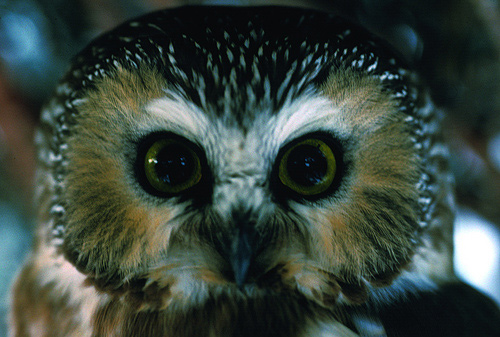The tiny northern saw-whet owl is the smallest owl in New England. They have a round head with a facial disk and brown feathers with white streaks. Their eyes are yellow. The adults weigh between 2 1/2 to 4 1/2 ounces and their wingspans are generally 17 to 21 inches.
Owls fly very quietly. They have specially-designed, sound-absorbing feathers that allow them to accomplish silent flight. Their feathers tend to absorb high-frequency sound, and in addition the leading edges of their wing feathers have a fringe called flutings that both aid in stable flight and muffle the sound of air moving over the wing. Feathers trailing from the back of their wings mitigate sound waves produced by air flowing over the wing and off of the back.
The most commonly heard call of the saw-whet owl is a long series of piping, high-pitched, short hoots. The hoots are very regularly-spaced. These owls can also make calls sounding like twitters, barks and whistles.
It is sometimes claimed that these owls got their name from James Audubon who thought their calls sounded like a saw being sharpened with a whet-stone. A French-Canadian name for these owls is "chouette" which means small owl. Some think the name "saw-whet" came from the French-Canadian term.
Saw-whet owls are year-round residents of northern New England, the west coast and other western areas of the US, and part of north-central Mexico. They overwinter across the northern section of the US and push into the southern edges of Canada in the summer.
Saw-whet owls regularly spend the winter in Connecticut, but are not seen very often. They are a species of Special Concern in this state.
Saw-whet owls favor forest habitat and like roosting sites in dense cover. They are migratory and may pass through other habitats as they migrate. These owls are solely nocturnal.
Saw-whet owls eat small rodents, small birds and insects. They usually eat only half of something like a mouse at a time and stash the rest on a branch. 4 or 5 hours later they retrieve it to finish it off. In winter the second portion of their meal may have frozen and the owl must thaw it out by holding in next to its body as if incubating an egg. Saw-whet owls regurgitate the undigestible parts of their food, such as bones and hair, in a lump called an owl pellet.
Saw-whet owls do not breed or nest in Connecticut. They are monogamous only through breeding and raising chicks. Between March and July they will lay 4 to 7 eggs using old woodpecker cavities or nesting boxes for nests. The male feeds the female while she incubates the clutch. Both parents feed the young for about 4 to 6 weeks. The young owls are independent at about 10 to 13 weeks. If the climate is amenable and the food supply sufficient the females may take a second mate and raise another clutch in the same season. The saw-whet owl's lifespan can be up to 7 years.
